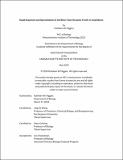Rapid Expansion and Specialization of the Bitter Taste Receptor Family in Amphibians
Author(s)
Higgins, Kathleen W.
DownloadThesis PDF (13.78Mb)
Advisor
Weng, Jing-Ke
Gehring, Mary
Terms of use
Metadata
Show full item recordAbstract
In classic sensory literature, bitterness is viewed as an early-warning system for toxic or spoiled foods. In vertebrates, bitterness is detected with a family of intronless G protein-coupled receptors called TAS2Rs. TAS2Rs are well studied in the human and mouse mouth, but recent studies have explored additional species and reported extra-oral expression of a subset of receptors. Here, we systematically search 680 vertebrate genomes, identifying 9,291 TAS2Rs. We determine that frogs and salamanders (“batrachians”) have an elevated number of TAS2Rs, and explore several processes that may have contributed to this increase through enhancement of non-allelic homologous recombination. Specifically, we find differences related to location along the chromosome, presence and size of TAS2R clusters, neighboring repeat elements, and proportion of copy-number constrained genes. We also find that total TAS2R count is metastable between closely related species, although there is evidence of either rapid gene turnover and/or gene conversion. Next, we narrow our analysis to five scientifically and ecologically relevant batrachian species, and perform deep RNA sequencing of seven oral and extra-oral tissues. We find that the tongue is the primary site of TAS2R expression, but that a significant number of receptors are expressed extraorally. Indeed, total genomic TAS2R count is directly proportionate to the number of TAS2R receptors that are expressed but not in the tongue. This suggests that the expanded TAS2R repertoire in batrachians may relate to tissue-specific specialization. An in vitro functional assay shows that batrachian TAS2Rs are able to respond to a host of classic bitterants, in addition to several novel chemicals. We find that several frogs have liver-expressed receptors for the hepatotoxin aflatoxin, providing a unique example of a toxin detected at its target organ. We find that two toad toxins are broadly recognized by receptors in the mouth, intestines, and liver, providing clues about the dietary and post-prandial response to toxin ingestion. We also find that the cane toad has skin receptors recognizing its own skin-expressed toxin, marinobufagenin, raising the possibility of an auto-regulatory pathway.
Date issued
2024-05Department
Massachusetts Institute of Technology. Department of BiologyPublisher
Massachusetts Institute of Technology